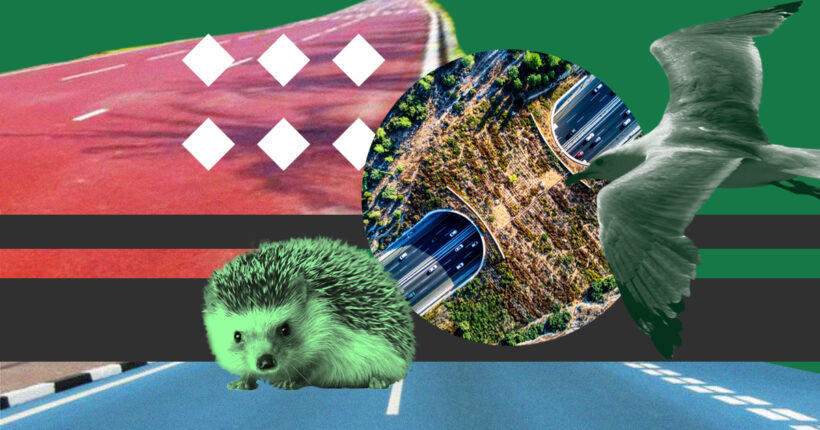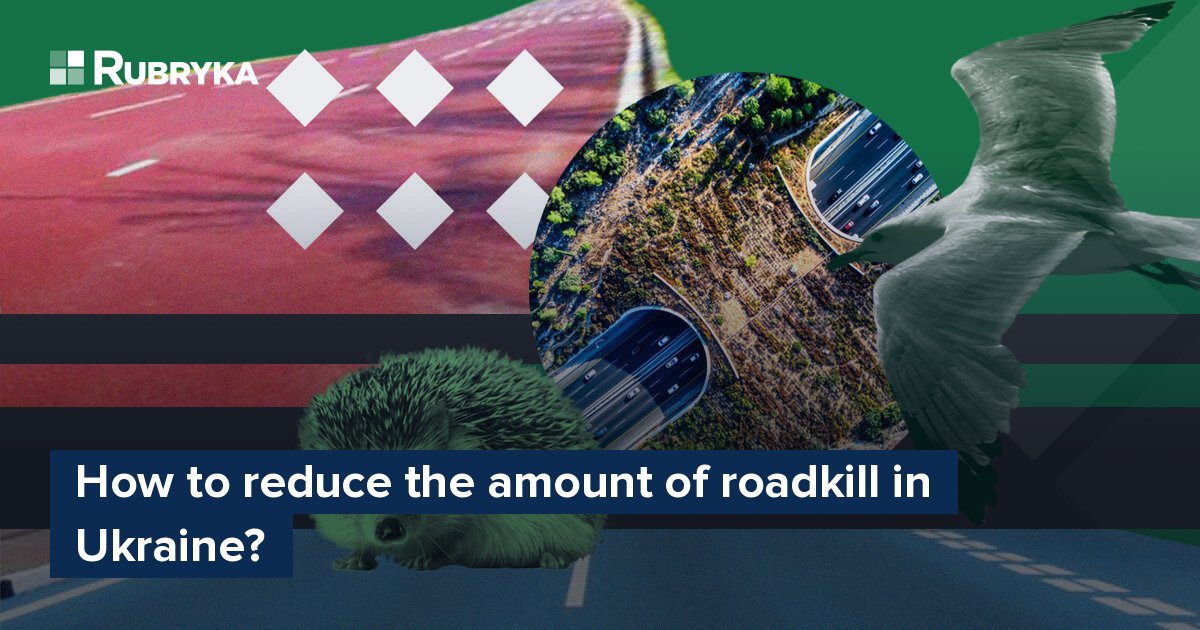
What is the problem?
Roadkill is a result of the growing automobile traffic. Car collisions are one of the most common causes of wildlife death.
Every spring and summer, the situation worsens due to many factors: climate changes, animal life cycle, migration, etc. As the number of vehicles and roads increases, the number of roadkill will eventually multiply. However, there are solutions that can change this horrific progression. Rubryka found out what these are and what to do to save both the lives of animals and the nerves of drivers.
What is the solution?
Ukrainian scientist and ecologist Viktor Parkhomenko has been conducting field research for 20 years, starting in 2000, to determine the main factors of animal death on the roads. He defined 24 main factors that affect roadkill. Most of them are related to the type, color, and even temperature of the road, vehicles, and drivers. In the study, the author cited several possible solutions already working in other countries, some of them being completely non-obvious.
Brightly-colored roads
Parkhomenko claims that the color of the road surface plays a vital role in the statistics of roadkill: the darker it is, the more animals, especially birds and insects, die.
The scientist found that seabirds often land on dim, light, or dark roads in coastal areas. This is primarily due to the higher temperature and the convenience of a place to rest and take off. Therefore, the brightly-colored roads, especially painted red, can scare away birds.

A road in Qatar. Photo: Noushad Thekkayil
In some countries, such painting is also used to reduce the road temperature. Firstly, this solution can reduce the air temperature in the area. Secondly, it can save the lives of aquatic animals and birds that mistake the haze of hot asphalt for the surface of a water body.

A section of the road is covered with a special coating to reduce the temperature. Doha, Qatar. Source: atlasobscura.com
For example, the 200-meter-long experimental section in Qatar was covered with a special 1-millimeter blue coating with a heat-reflective pigment and hollow ceramic microspheres that effectively reflect infrared radiation.
LED road lighting
Surprisingly, energy-saving lighting on roads has a double effect. Viktor Parkhomenko points out that the old "yellow" lighting (mercury lamps) attracts insects and various animals at night, which, in turn, are food for birds and can be deadly bait.
With today's transition to the use of sodium-vapor, energy-saving, and LED lamps, the light of which barely attracts insects, fewer animals are dying in the open.
Several studies confirm this in observations in the suburbs of Ukraine's eastern Sumy. After replacing the power-consuming lamps with LED ones, 4-7 times fewer hedgehogs died.

Illustrative picture
Overhead bridges and flyovers
Animal bridges allow wildlife species to cross lanes and other dangerous areas separated by a road. They are called ecoducts. These constructions are made to navigate mammal species, crabs, and even parrots.
"Ecoducts can be similar to bridges, tunnels, or pipelines. Their design depends on the size of the animals. For example, underground tunnels are built for larger animals, while hedgehogs and other small animals use pipes," comments ecologist Yuliia Avramenko.
This construction can prevent the death of animals on the road. Ecoducts have their cons, such as making animal herds "degenerated". Since the road prevents migration, herds cannot find new partners, so new cubs may be born with genetical issues.

A flyover for animals in Israel. Source: Wikipedia
Overhead crossings covered with plants are built in well-chosen areas based on the migration routes of wildlife species.

Sometimes, animal bridges are built under highways. This road piece is in Kuwait. Wikipedia
Ukraine still lacks such crossings, but thanks to the WWF (World Wide Fund for Nature), international researchers started studying this issue in the Carpathian region and the state. In 2018, the government approved a new transport strategy for Ukraine until 2030, which includes WWF's proposals for greening transport infrastructure and building ecological crossings for wildlife. However, so far, Ukrainians have not noticed any such solutions.
Rubryka has already posted a tutorial for Ukrainians to initiate building flyovers for animals in their hometowns.
Where does roadkill happen the most?
- Broad highways. On a one-lane road, an animal can choose to cross the road when the traffic is the least jammed, while it is a challenge with two or more lanes.
- Сurbs and fences. The curbs along the road are a trap for small animals, which causes shrews, amphibians, reptiles, beetles, caterpillars, and other species easily get on the road, but cannot cross it and eventually die on their way out. Due to the road's barrier obstacles, only 10% of mammals crossing lanes 6-15 meters wide succeed.
- Intersections
- Highway bridges. Birds and even bats use these areas to nest. Passing such constructions with a vehicle can be risky.
- Empty roads. Loud and jammed traffic causes a lot of noise. Animals are less likely to cross the road in such places, being afraid of both sounds and fast cars. It is somewhat different on an empty highway: when a single car is moving, animals can jump out of the forest on the road unexpectedly.
- Newly built highways. They have the highest rates of roadkill and reduce populations of the most vulnerable species. Ecologist Viktor Parkhomenko cites a study in Western Europe that shows that 14.7 to 16.3 birds died on a 100-kilometer stretch of the old highway, while 28.8 died on a newly built one. Similar data was noted in Ukraine, on the Kinburn Spit in southern Mykolaiv and Kherson regions, where the share of dead vipers increased almost eight times after the launch of a new road, from 3-4% to 20-28%. Fixed roads result in the same roadkill.
"To prevent roadkill, signs such as "Beware of wild animals" are installed on highways near forests. The driver should slow down and drive carefully along the indicated section of the road." environmentalist Yuliia Avramenko also added.
How to act if you hit an animal while driving?
Scientists from Denmark conducted a survey among local drivers. Around 80% of them responded that they had suffered an accident with a wild animal. They had a split second to make a responsible decision and pull from the road.
This can happen to anyone, even if the driver does not exceed the speed limit and follows all traffic rules. So, what should he do if he hits an animal?
According to the rules of the traffic code, you must follow the following steps:
- You must never leave the scene of an accident, regardless of the size of the animal (moose, cat, dog, chicken).
- Put up an emergency stop sign and call the police. If the driver leaves the scene, he or she will face a fine and license disposal.
- If there are injured people, you need to call an ambulance.
- Collect all the evidence at the accident scene and get information from witnesses, if there were any. Take photos and talk to other drivers or locals. It is worth finding out who owns the animal.
- Usually, the driver is not to blame for the accident but the animal that suddenly jumped out. If it is a domestic animal, you can try to resolve the conflict with its owner peacefully.
- If you hit an unleashed dog, the pet's owner will be to blame for the accident.
- If the driver is not responsible for the accident, he or she is not obliged to pay compensation. However, he will have to pay for the repair of his car on his own.
How to rescue an animal?
- Ukrainians can contact the ZooPatrol UA organization for help. The initiative rescues up to five animal patients every day. So, if one sees an injured animal, he can call the relevant number, and a patrol will arrive on the spot, take the animal, and provide the necessary assistance. After treatment, the animals are taken to a shelter, and the adoption department finds a new family.
Newsletter
Digest of the most interesting news: just about the main thing




